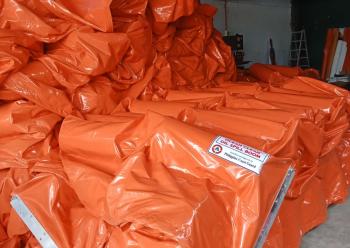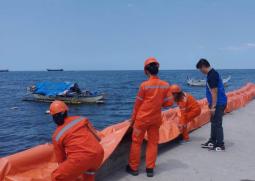
Oil Spill Boom (Solid Type)
Durable, High-Buoyancy Containment for Oil Spill Control
Our Solid Type Oil Spill Booms are engineered for fast deployment, excellent buoyancy, and strong oil containment in both calm and open waters. Ideal for ports, terminals, marine facilities, and offshore operations, these booms are made with high-visibility, UV-resistant materials and equipped with ASTM universal end connectors for seamless extension and secure connections.
Key Features:
-
PCG-Accredited – Meets Philippine national standards for oil spill containment
-
Solid Floatation Design – Provides stable buoyancy even in rough or tidal waters
-
High Freeboard and Deep Skirt – Prevents oil from breaching over or under the boom
-
Universal ASTM End Connectors – Quick coupling with other boom segments
-
UV and Chemical-Resistant – Engineered for long-term marine and industrial use
Available Sizes:
Model A – Large Solid Boom
-
Floater Size: 10" dia x 24" length
-
Freeboard: 14"
-
Skirt Depth: 24"
-
Total Width: 36"
-
Connector: ASTM Universal End Connector
-
Recommended For: Open waters, harbors, oil depots, offshore containment
Model B – Compact Solid Boom
-
Floater Size: 6" dia x 12" length
-
Freeboard: 25 cm
-
Skirt Depth: 25 cm
-
Total Width: 60 cm per segment
-
Connector: ASTM Universal End Connector
-
Recommended For: Rivers, docks, calm waters, and restricted spill zones
How to Deploy:
-
Prepare the Area: Assess the wind, current, and spill direction. Position boom deployment starting upwind or upstream.
-
Unroll or Unstack Boom Segments: Place the boom at the water's edge or on a vessel’s deck. Ensure connectors are accessible.
-
Connect Boom Sections: Use ASTM connectors to link each segment. Tighten and secure the pins and toggles.
-
Deploy Slowly: Using a boat or manual handling, gently pull the boom across the water while uncoiling. Avoid kinks or sharp bends.
-
Anchor Ends if Needed: Use anchor lines or mooring points to fix ends in place, particularly in tidal or moving water.
How to Retrieve:
-
Slowly Reel In: Begin pulling the boom back from one end using a winch, rope, or boat—slowly and evenly.
-
Disconnect Sections: As you retrieve each segment, remove the ASTM connectors for easier handling.
-
Rinse & Inspect: Wash off any oil and debris with fresh water. Inspect for damage before storage.
-
Dry and Store: Allow all components to dry completely, then store in a dry, shaded, and well-ventilated area to prolong service life.
Applications:
-
Oil spill emergency response
-
Coastal and inland water containment
-
Ports, shipyards, and fuel depots
-
Power plant intakes/outflows
-
Industrial discharge zones





